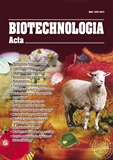ISSN 2410-7751 (Print)
ISSN 2410-776X (Online)

Biotechnologia Acta Т. 17, No. 2 , 2024
P. 38-40, Bibliography 9, Engl.
UDC::612.8: 577
DOI:https://doi.org/10.15407/biotech17.02.038
PREVENTION OF MERCURY-INDUCED EXCITOTOXICITY IN PRESYNAPTIC BRAIN NERVE TERMINALS WITH CARBON DOTS
M.Driuk, N. Krisanova, N. Pozdnyakova, M. Dudarenko, A. Pastukhov, T. Borisova
Palladin Institute of Biochemistry of the National Academy of Sciences of Ukraine, Kyiv
Aim.
According to the World Health Organization's assessment, xenobiotic metal mercury is a significant pollutant that causes global public health concerns. Carbon-containing nanoparticles (CNPs) are promising in nanotechnology. CNPs were obtained by the combustion of citric acid and urea.
Methods. The cortex nerve terminals isolated from Wistar rats were used in the experiments. [14C]glutamate uptake and release in the nerve terminals were monitored using a radiolabeled assay.
Results. It was shown that HgCl2 starting from 5 µM caused a concentration-dependent increase in the extracellular L-[14C]glutamate level in nerve terminals resulting from weak glutamate transporter functioning, significantly decreasing L-[14C] glutamate uptake. The combined effects of Hg2+ and CNPs obtained by heating citric acid and urea were analyzed. CNPs were able to mitigate in an acute manner excitotoxic Hg2+-induced increase in the extracellular L-[14C]glutamate level in nerve terminals by 37%, thereby being a provisional Hg2+ scavenger.
Conclusion. Besides the biotechnological implementation of data, the developed approach can be applicable for monitoring the capability of different particles and compounds to mitigated Hg2+ -mediated threats.
Key words: mercury, glutamate, neurotoxicity, nerve terminals, synaptosomes, carbon nanoparticles.

